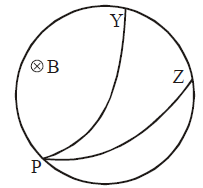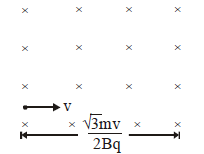A charge q coulomb moves in a circle with n revolutions per second and the radius of the circle
is r metre. The magnetic field at the center of the circle is :
No solution provided for this question.
A charge q coulomb moves in a circle with n revolutions per second and the radius of the circle
is r metre. The magnetic field at the center of the circle is :
No solution provided for this question.
A charged particle moves along a circle under the action of possible constant electric and magnetic fields. Which of the following are possible ?
No solution provided for this question.
Two particles Y and Z emitted by a radioactive source at P made tracks in a chamber as illustrated in the figure. A magnetic field acts downward into the paper. Careful measurements showed that both tracks were circular, the radius of Y track being half that of the Z track. Which one of the following statements is certainly true ?

No solution provided for this question.
A charged particle enters a uniform magnetic field with velocity vector at an angle of 45° with the magnetic field. The pitch of the helical path followed by the particle is p. The radius of circle
of the helix will be :
No solution provided for this question.
A charged particle of mass m, charge q is moving with speed v. It enters a uniform magnetic field acting perpendicular to the plane of paper inwards as shown in Fig. The width of the
magnetic field is √3 mv/2qB . Then time taken by charged particle to emerge from the magnetic
field is :-

No solution provided for this question.
An eΘ is moving in North direction & magnetic field at this place is along upward direction then
eΘ will be deviate towards :-
No solution provided for this question.
A proton is moving along y-axis with velocity 200 m/s & magnetic field of magnitude 1 μT is
acting at 30° angle to the y-axis. Then radius of circle in its helical path will be :-
No solution provided for this question.
An eΘ is moving in a zero gravity region towards upward direction & magnetic field in this region is along east direction. Then what will be the direction of electric field in this region so that eΘ can remain undeflected :-
No solution provided for this question.
The acceleration of an eΘ at a certain moment in a magnetic field
\[\overrightarrow{B}=2\hat{i}+3\hat{j}+4\hat{k}\] is
\[\overrightarrow{a}=x\hat{i}+\hat{j}-\hat{k}\] .
The value of x is :-
No solution provided for this question.
The radius of curvature of the path of the charged particle in a uniform magnetic field is directly
proportional to
No solution provided for this question.